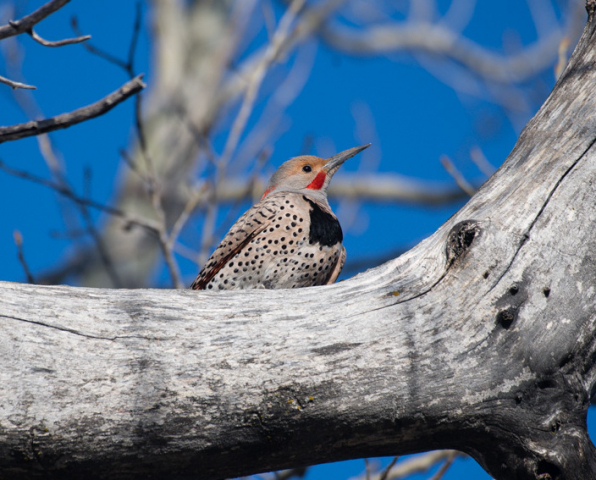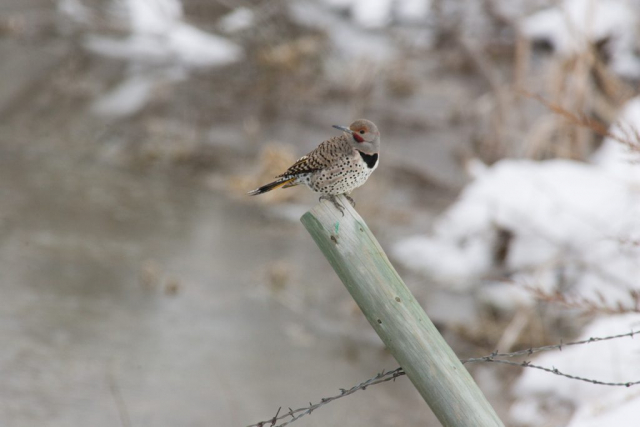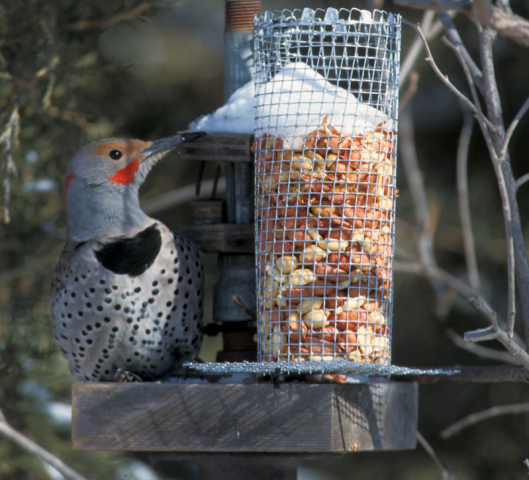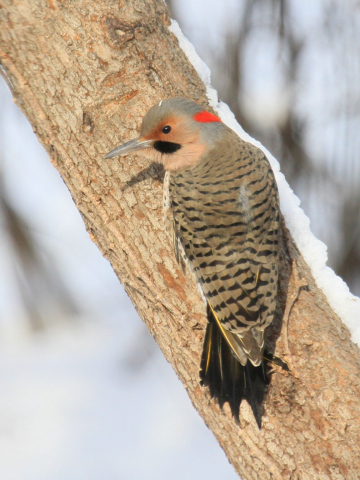Joel G. Jorgensen and W. Ross Silcock | joel.jorgensen@nebraska.gov, silcock@rosssilcock.com | 28 December 2020
The Northern Flicker (Colaptes auratus) is a common species that has two field identifiable subspecies, the “yellow-shafted” flicker (YSFL) and the “red-shafted” flicker (RSFL). The problem and challenge for Nebraska birders is that YSFLs and RSFLs regularly interbreed and the intergradation zone covers much of the state. This means that throughout the year birders may be more likely to encounter intergrades in some areas rather than “pure” YSFLs or RSFLs, especially in central and western Nebraska. Furthermore, many flickers that appear to be one form or the other based on the color of their wing and tail feather shafts actually show signs of intergradation upon closer inspection. The purpose of this post is to provide helpful guidance to birders, and especially eBirders, on what are the key field marks distinguishing YSFLs, RSFLs and intergrade flickers and how to report their observations.
Taxonomy
The Northern Flicker actually includes nine subspecies, four occurring south of the United States and five from Texas northward (AviList 2025). The latter five subspecies are separated into two subspecies groups, RSFLs and YSFLs. The three RSFL subspecies are cafer of coastal Alaska to northern California, collaris of the southwestern USA, east to southwest Saskatchewan and south to Texas, and nanus of west Texas to northeast Mexico. The YSFL group consists of luteus (includes borealis) from central Alaska to eastern Canada, south to the northern edge of the USA, and auratus of the southeast USA, south of luteus, and west to eastern North and South Dakota, the eastern half of Nebraska, most of Kansas and Oklahoma, and from east Texas eastward. West of the range of auratus is a wide intergradation zone where “yellow-shafted” auratus and “red-shafted” collaris meet.
The center of the intergradation zone, which has been stable in position and width since the late 19th century (Wiebe and Moore 2024) and is relatively young, only 4000-7500 years (but possibly older) and since the Last Glacial Maximum (Wiebe and Moore 2024), passes from the Black Hills of South Dakota southward through Chadron to near Crook in northeast Colorado (Short 1961). There are probably no “pure” collaris in Nebraska in summer (Short 1961), and possibly only very few “pure” auratus in extreme eastern Nebraska, with most summer birds being intergrades (Short 1961); few parental types occur within the rather wide intergradation zone, where mating is random (Sibley and Monroe 1990).
In winter, most birds in western Nebraska are at least “salmon-colored” (Rosche 1994), with some occurring east to the Missouri River; perhaps some fairly pure collaris appear also in the west (Andrews and Righter 1992), although all collected specimens are intergrades (Rapp et al 1958). Many migrants and wintering birds are northern “yellow-shafted” birds that show very little intermediate character (Andrews and Righter 1992). Two birds labeled borealis (=luteus) in the Hastings Municipal Museum (HMM 26960) were collected in Adams Co 9 Feb 1951.
Identification
Identification of YSFLs, RSFLs and intergrades should be done considering color of the feather shafts, face, malar and nape. The typical YSFL has yellow feather shafts, brown face, black malar (brown in females) and a red crescent on the nape. The typical RSFL has red feather shafts, gray face, red malar (brown in females) and a gray nape. Intergrades may have intermediate features or features of both forms. Examples of the former includes birds that have salmon colored shafts or malars that have both red and black coloration. An example of the latter include birds that may appear like a “red-shafted” but also possess a red nape crescent, which is a characteristic of YSFLs. The photographs above include flickers that are intergrades. In addition, good overviews of flicker identification can be found at the following links.
http://birdhybrids.blogspot.com/2014/06/norther-flicker-intergrades.html
Recommendations to Observers
Many of the users of the Birds of Nebraska – Online are also observers who report their sightings, most often to eBird (www.eBird.org). As with a similar post about towhees (see https://birds.outdoornebraska.gov/pipilo-towhees-in-nebraska/), the intent of this post is provide guidance and helpful recommendations on how to report flickers. Our Nebraska eBird reviewers set their filters to zero for some regions and seasons, which requires observers to provide documentation. For example, reporting a RSFL in the Panhandle in June will flag and the observer will need to add further details. In general, the following are the guidelines that reviewers follow:
Northern Flicker: This always the safe option for any flicker seen anywhere in Nebraska at any time. Observations are not unusual and are not flagged.
Northern Flicker (Yellow-shafted): Summer observations of “pure” YSFLs in the panhandle are expected to be few and far between and are flagged. Flickers breeding in the panhandle are expected to be intergrades.
Northern Flicker (Red-shafted): Observations statewide, including the panhandle, are not expected and are flagged during summer; observations in the eastern half of Nebraska are flagged year-round.
Northern Flicker (Yellow-shafted x Red-shafted): Observations in the eastern two thirds of the state are flagged during summer. Note that eBird only provides the option that implies a F1 hybrid (two species interbreeding typically resulting in infertile offspring), but the two flicker population breeding ranges broadly overlap and offspring are fertile.
We recommend observers consider more than just shaft color when reporting a flicker to a subspecies or as intergrades in areas or during periods when those reports are not expected and are flagged. Carefully studying birds for signs of intergradation and reporting that information in eBird checklists will greatly assist reviewers. This will hopefully lead to an improved understanding of the distribution of flicker subspecies in the state.
More about the Northern Flicker in Nebraska can be found in the species account: https://birds.outdoornebraska.gov/northern-flicker/
Literature Cited
AviList Core Team, 2025. AviList: The Global Avian Checklist, v2025. https://doi.org/10.2173/avilist.v2025.
Rapp, W.F. Jr., J.L.C. Rapp, H.E. Baumgarten, and R.A. Moser. 1958. Revised checklist of Nebraska birds. Occasional Papers 5, Nebraska Ornithologists’ Union, Crete, Nebraska, USA.
Rosche, R.C. 1982. Birds of northwestern Nebraska and southwestern South Dakota, an annotated checklist. Cottonwood Press, Crawford, Nebraska, USA.
Rosche, R.C. 1994. Birds of the Lake McConaughy area and the North Platte River valley, Nebraska. Published by the author, Chadron, Nebraska, USA.
Short, L.L., Jr. 1961. Notes on bird distribution in the central Plains. NBR 29: 2-22.
Sibley, C.G., and B.L. Monroe, Jr. 1990. Distribution and taxonomy of birds of the world. Yale University Press, New Haven, Connecticut, USA and London, England.
Wiebe, K.L., and W.S. Moore. 2024. Northern Flicker (Colaptes auratus), version 2.1. In Birds of the World (P. G. Rodewald and B. K. Keeney, Editors). Cornell Lab of Ornithology, Ithaca, NY, USA. https://doi.org/10.2173/bow.norfli.02.1.



